Lance-Sergeant. Stanley Halliwell. ‘B’ Troop, 1st Parachute Squadron, RE
Stanley Halliwell was born on the 19 November 1919, and came from Upton-By-Chester in Cheshire. He enlisted into the Royal Engineers on the 10 January 1940. [1], Stan had a great passion for rugby league and in his younger days played for St. Helens school boys. Later in life his father Alfred, moved to Upton-by- Chester and he started a family business Alfred Halliwell & Sons Builders, where Stan, before he enlisted, started work as a joiner.
He volunteered for Airborne Forces in 1941 and was taken on the strength of the 1st Air Troop, Royal Engineers on the 1 November 1941, at Hardwick Hall, Camp. After the selection process he did parachute course No 4, at RAF. Ringway, 17 – 23 December 1941, along with 15 other men of the 1 Air Troop, RE [2]
He was a member of the Section of Engineers, under the command of Lt. ‘Dennis’ Vernon, that took part in the parachute operation at Bruneval, in Northern France, on the night of the 27/28 February 1942. He parachuted from A/C: 9164 accurately over the drop zone, as part of ‘Hardy’ Section, and made his way to the Wurzburg radar, where he was tasked with cutting the power cables. He, and the rest of the Engineers Section, withdrew successfully back to the beach and were extracted with the dismantled parts of the radar by Royal Navy manned landing craft, and transported back to England.
He also took part in the North African campaign, as a member of ‘B’ Troop in the now 1st Parachute Squadron, Royal Engineers. ‘B’ Troop was attached to the 2nd Parachute Battalion, and was now commanded by Capt. ‘Dennis’ Vernon. They took part in the parachute operation on the 29 November 1942 at Depienne in Tunisia, and the subsequent action at Oudna. Although many miles behind the enemy lines, and cut off, due to the cancellation of the 1st Army’s ground operation, they fought their way back to Allied lines.
By now a Corporal, Stanley was due to take part in the parachute operation to capture the Primosole Bridge in Sicily on the night of the 13/14 July 1943. However, although they successfully took off in A/C: 90, they were not able to jump, as the ‘Stick Commander’, Capt. TJ Livesey (the new commander of ‘B’ Troop) wrote in his report: ‘Plane was fired upon. Pilot was shot in thigh or stomach, Navigator in head. Co-pilot refused to continue as he said a/c was damaged & he would be unable to make the return journey, & was not sure of his location. Containers were jettisoned into the sea as co-pilot considered they were possibly damaged & might affect his controls. Holes in fuselage & cockpit damage to instrument panel & rudder controls (according to co-pilot also possible damage to starboard engine)’. [3]
After this disappointment the Squadron then took part in the naval landings at the port of Taranto in Southern Italy in September 1943, and ‘Stan’ was now promoted to Lance Sergeant. In November/December the Squadron returned to England and was billeted in Donington in Lincolnshire.
On Sunday, 17 September 1944, ‘Stan’ boarded a Dakota aircraft of the USAAF at Barkston Heath aerodrome and took off to take part in Operation ‘Market-Garden’. He successfully dropped onto DZ. ‘X’ near Renkum in Holland. The following is taken from various accounts:
‘Stan’ Halliwell was a 25 year old engineer and a member of the 1st Parachute Squadron that fought at Arnhem Bridge. On the morning of Tuesday 19, he was taking ammunition to an isolated position that was held by other members of the 1st Para Squadron, but he was captured by German infantry on the way.
Later in the day, Halliwell was offered the chance to temporarily return to his comrades under a flag of truce. The Germans believed that Frost's defence of the Bridge was futile and that he had no hope of being relieved by friendly forces; Halliwell was told to put these facts to John Frost and encourage him to surrender. The German Officer who briefed him added that they trusted him as a gentlemen to return and hand himself over to German troops once he had been given a reply. Halliwell was provided with an escort across the Bridge, but there was no truce and the Bridge defenders opened fire. Stan ran across and shouted out to friendly troops not to shoot him. He ran from building to building amongst all the fighting, during a period that he describes as the worst ten minutes of his life. Eventually he made it to Lt-Colonel Frost's HQ, and he informed him of the proposal. He also took the liberty of telling him that their SS opponents seemed to be very disheartened by their extremely heavy losses, news that gave John Frost reason for momentary cheer. However Frost's reply to the offer of surrender was blunt, and he told Halliwell to return and tell them to go to hell. Stan didn't relish telling them that, nor was he enthusiastic about getting back across the Bridge again. Frost said that the decision was entirely up to him, so Stan Halliwell remained with his men and took his place in the Bridge defence once more, reasoning that the Germans would probably be able to guess the reply before long.
Interview for Cornelius Ryan;
L/Sgt. Stanley Halliwell
B Troop 1st Para Sqdn R.E.
1st Para Bde
1st Abn Div
Telephone call 10 Jan. l968
‘L/Sgt. Stanley Halliwell remembers witnessing a heroic incident on the 18th [19th?] [A] September. Halliwell himself was on the ground floor of a 3 story building which stood on a road running underneath the bridge at Arnhem. From the back of the building if one was on the top floor (Halliwell says they moved from floor to floor) you can see on the bridge and from the front you could see the street and square. Early in the morning of the 18th [19th] Sept.at about 7am. Halliwell and about 2 or 3 others including Sapper [Wilfred] Skinner (also of B Troop) were looking out on the road. Some British infantrymen were dug in on a grass verge in the middle of the road. About 20 yards to the right of Halliwell and company as they looked out was a Tiger tank. To Halliwell’s left on the opposite side of the road at a ‘T’ junction was a six pounder anti-tank gun.(about 30-40 yards to the left). The Tiger tank moved to within about 70 yards of the A-tk guns position, the A-tk gun being situated so as to be able to fire down the side street or to swing round and fire down the main street.
There was a crew of 3 in the A-tk gun and the fire of the anti tank gun did not seem to take effect on the tank at all. He just came on and on. First the Germans opened with machine gun fire which peppered the light metal shield in front of the gun. The 3 men on the A-tk gun fell, but one dragged himself to his feet. Halliwell thinks it was a sergeant; he reloaded the gun and fired, again without must effect. The tank then fired one shot with its main armament. There was a cloud of black smoke round the anti-tank gun, then silence. Halliwell was impressed by the heroism of this 3rd gunner, because he says he must have realized that the fire of his gun was little use. Also, Halliwell says he stuck to his post with no hope of survival when he had only to move about 5 or 6 feet to reach cover of a building.
Having silenced the A-tk gun. the Tiger tank moved down the street very slowly firing at each house as it passed it. Halliwell says he presumes they were firing armoured piercing shells because they went through the walls of the houses and out the backs of them without exploding.
Halliwell was captured twice. First at about 11 am on the 19th when he was in a building near the bridge; he thinks it was a waterworks. The building was overrun and he was taken to a German position also near the bridge. When he arrived a German commander asked him (Halliwell) to take a message to Colonel Frost asking him to meet the German commander at a certain time. Halliwell thinks it was about 3PM, but is not certain. The Germans made Halliwell promise on his honour that he would return to captivity after delivering the message. Halliwell delivered the message to Colonel Frost who just commented “He can go to hell”. Halliwell explained that he had given his word of honour that he would return to captivity and Frost said it was up to him to decide what to do. Halliwell started to make his way back to the Germans but on approaching a wall, he was confronted by machine gun fire so he decided to make for safety, saying to himself the Germans could come and look for him if they wanted to.
He was able to re join his unit afterwards. Halliwell was recaptured on the 22 September when they were holding a position on the river bank about 300 yards from the bridge. The block of houses or flats we were in was set on fire and the only alternative to burning alive was surrender. The Germans marched them through Arnhem (they spent the night in a cellar at Arnhem) to Zutphens.
Halliwell first saw the sailor when they were almost at Zutphen. Halliwell has nothing special to add to other accounts of the sailor - only that he maintains he was wearing typical naval gear bell bottoms and a naval collar.’
‘Stan’ was taken prisoner on the 20 September 1944, in the Bridge perimeter area, and was then transported – by cattle truck - to Stalag 12A at Limburg in Germany. Arriving there on the 25 September he was given the POW no. 89623. On the 12 October he left there, bound for Stalag 2A at Neubrandenburg, arriving on the 16 October. He was there until the 29 April 1945, when he was liberated by advancing Allied Forces. [1]
NOTES:
[1] POW questionnaire. 16th May 1945.
[2] Parachute Course Report, R.A.F. Ringway. December 1941.
[3] 1st Parachute Squadron, R.E. War Diary. After Action Report. 22 July 1943.
[A] This incident must have taken place on the early evening of 19th September, as that is when the Tiger I’s of Panzer Kompany ‘Hummel’ appeared. Gun B1, ‘B’ Troop, 1st A/L A-Tk Bty, R.A. was commanded by Sgt. H.E. Doig, who is reported to have been killed 20-21/09/44.
The Reader’s Digest Association Limited, 25 Berkeley Square, London W1. regarding interview with Cornelius Ryan
Stanley Halliwell Esq,13 Lawn Drive, Upton-by-Chester, Cheshire.16 May, 1967.
Dear Mr. Halliwell,
Your name appears in the records of those who may have taken part in the airborne assault on Holland in September, 1944. I am therefore writing to ask for your help with some research that we are doing on behalf of Mr. Cornelius Ryan, author of The Longest day and, more recently, The Last battle.
Would you be kind enough to answer the following questions in the spaces provided. Please return this letter to me as soon as possible so that Mr. Ryan may include your experiences in the account of the airborne invasion of Holland which he is planning to write. The book will include a chapter entitled “Where They Are Today”, in which your name and occupation will be listed with full acknowledgement. Your assistance will be very much appreciated.
Yours Sincerely,
Michael Randolph,
Editor, British Editions.
1). Are your name and address correct on this letter? If not, please amend them.
Yes.
2). If you can be reached by telephone, please give number.
Chester. 29423.
3). What is your present occupation?
Builder.
4). What was your rank and unit in September 1944?
L/Sgt. B-Troop, 1st Parachute Sqdn, R.E. 1st Parachute Brigade.
5). What was your age in September 1944?
25.
6). Were you engaged or married then? To whom? If married, did you have any children at that time?
Engaged Miss. D.M. Dawson, Donington, LINCS. Married on return from P.O.W. Camp in Germany.
7). Where were you born?
St. Helens, LANCS.
8). What previous action had you seen?
Too part as parachutists – Bruneval (France), Depienne (Tunisia), Primosole Bridge (Catania, Sicily), and finally Arnhem, taken prisoner.
9). When did you learn that you were going to take part in the operation in Holland?
10th Sept 1944.
10). What was your reaction? Were you, for example, anxious, resigned or relieved to be going into action?
After numerous false alarms and postponements, due to rapid advance of ground troops, I can honestly say relieved.
11). What was the trip like into Holland? Did you see anything unusual? Do you remember any conversations you had, or how you passed the time on the journey?
Main topic of conversation was the excellent cover given by the fighter escorts as we crossed the Dutch coast.
12). How did you feel about a daylight operation? Do you recall any conversations with your friends about it? What was said?
I cannot recall any conversation with friends, but for myself did feel a bit apprehensive about a daylight operation so close to the German border.
13). What were the rumours? Had you heard, for example, that if the invasion of Holland was successful, the war would be over by the coming winter?
We were told at the briefing before the operation, that if we were successful it would probably shorten the duration of the war by six months.
14). Did you keep a diary or notebook of what happened to you during any part of September, 1944? Do you still have it?
No.
15). Were any of your friends killed or wounded on the day of the drop or on subsequent days?
Yes.
16). Do you remember any conversations you had with them before they became casualties?
No.
17). Were you wounded or captured during this period? Can you give details?
I was taken prisoner on Sept 22nd, 1944. We were holding a position practically on the river bank about three hundred yards from the Bridge over the Rhine. The block of houses or flats we were in was set on fire, the only alternative to surrender was to be burned alive.
18). Do you remember any significant dealings you may have had with Dutch civilians or members of the Dutch Underground? Please explain.
None with the Dutch underground, but remember receiving plenty of encouragement, drinks, fruit, etc, as we made our way to the Bridge, after the drop.
19). What do you recall most vividly about the country of Holland?
The flat terrain, waterways, and mostly the friendly attitude of the people.
20). Do you recall any incidents with the Germans – fights, surrenders, truces or conversations you may have had with them afterwards?
Several, but to lengthy to record here.
21). Do you know of others who took part in the operation, to whom we might write? Please give their names and last-known addresses.
Mr. N. Swift.
KENT.
22). Do you recall seeing or hearing anything that seems humorous now, even though it may not have seemed so at the time?
I think the case of the sailor who went into captivity with us. Apparently he had a pal, who was pilot of one of the planes dropping supplies Monday. He brought the sailor on one trip after promising to have him back in England in time for tea. Unfortunately the plane was shot down and he finished up in the POW Camp.
23). Do you recall any incident, sad or heroic or simply memorable, which struck you more than anything else?
One heroic incident I witnessed on the 18th [19th?] Sept. The crew of a six pounder anti-tank gun, were in position at the corner of a cross-roads, and a Tiger tank had moved to within seventy yards of their position. The fire-power of the anti-tank gun did not seem to take any effect on the tank at all. He just came on and on. First the Germans opened up with machine-gun fire, which peppered the shield in front of the gun. Two men fell and the remaining man, I think he was a sergeant, he loaded the gun and fired, again without effect. The tank then fired one shot with its main armament, there was a cloud of black smoke round the anti-tan gun, then silence.
The reason I mention this was because of the heroism of this man. I don’t know who he was, but he must have realised that the fire-power of his gun was of little use, yet stuck to his post to the end, when by moving, five or six feet he could have reached the cover of a building.
Created with research conducted by R Hilton, J Howes. Images kindly provided by P Halliwell (son).
Read More

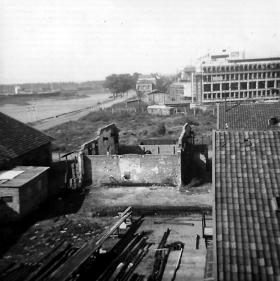
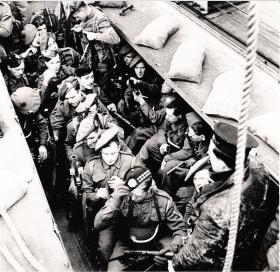
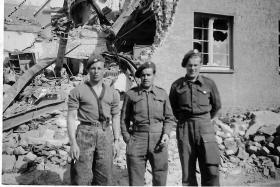
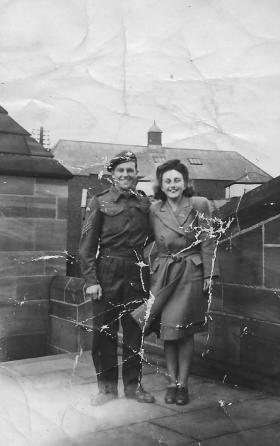
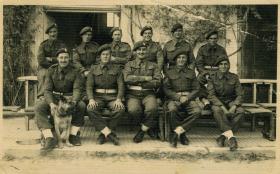
Latest Comments
There are currently no comments for this content.
Add Comment
In order to add comments you must be registered with ParaData.
If you are currently a ParaData member please login.
If you are not currently a ParaData member but wish to get involved please register.